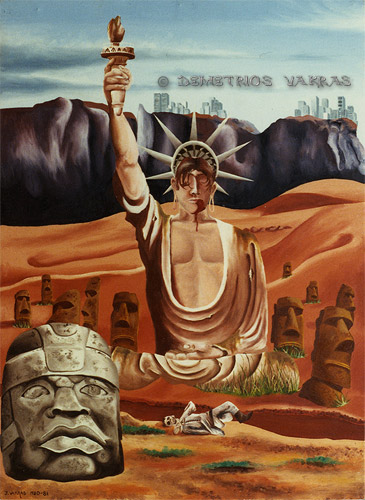

![]()

the instance of grievance when confronted with the falsehood of truth. oil on canvas. 1980-81 ©
demetrios vakras
|
The painting above is based on the drawing from the beginning of 1978 below
What follows is the essay that accompanied this painting/drawing. The essay had undergone various revisions since it was first written in 1978. The version that appears is the 1980 revision (with some amendments). |
|
Perched precariously on a cliff-top remain the last vestiges of man's civilization -buildings symbolic of man's 'higher' intelligence, his ability to construct, to create - his material obsessions. In the immediate foreground are scattered the abandoned relics of his past - abandoned to the solitude and desolation of the dessert wilderness, to the extremities of nature, left to crumble under a scorching sun, ... Here the grass is beginning to reclaim what once belonged to nature, the statues sculpted from stone slowly being reintegrated from whence they were extracted. These statues, remnants of past civilizations, are signposts of the path man has taken in history. In the bottom left hand corner is a sculpted head of the Olmec people of Mexico. And in the immediate centre of the painting the dominant figure fuses the joint features of the Statue of Liberty with a statue of the Buddha. Both are ideals of civilization. Grandiosely they were created by man to glorify his civilization, to symbolise the delusory concept of 'civilization' and symbolise the accomplishments of the people who created them. Behind the Statue of Liberty are the sculpted heads from Easter Island, receding into the distance still shrouded by the mystery of their creators. |
|
**(Of course, the Statue of Liberty was made in France and given as a gift to the fledgling democracy of the United States.)
|